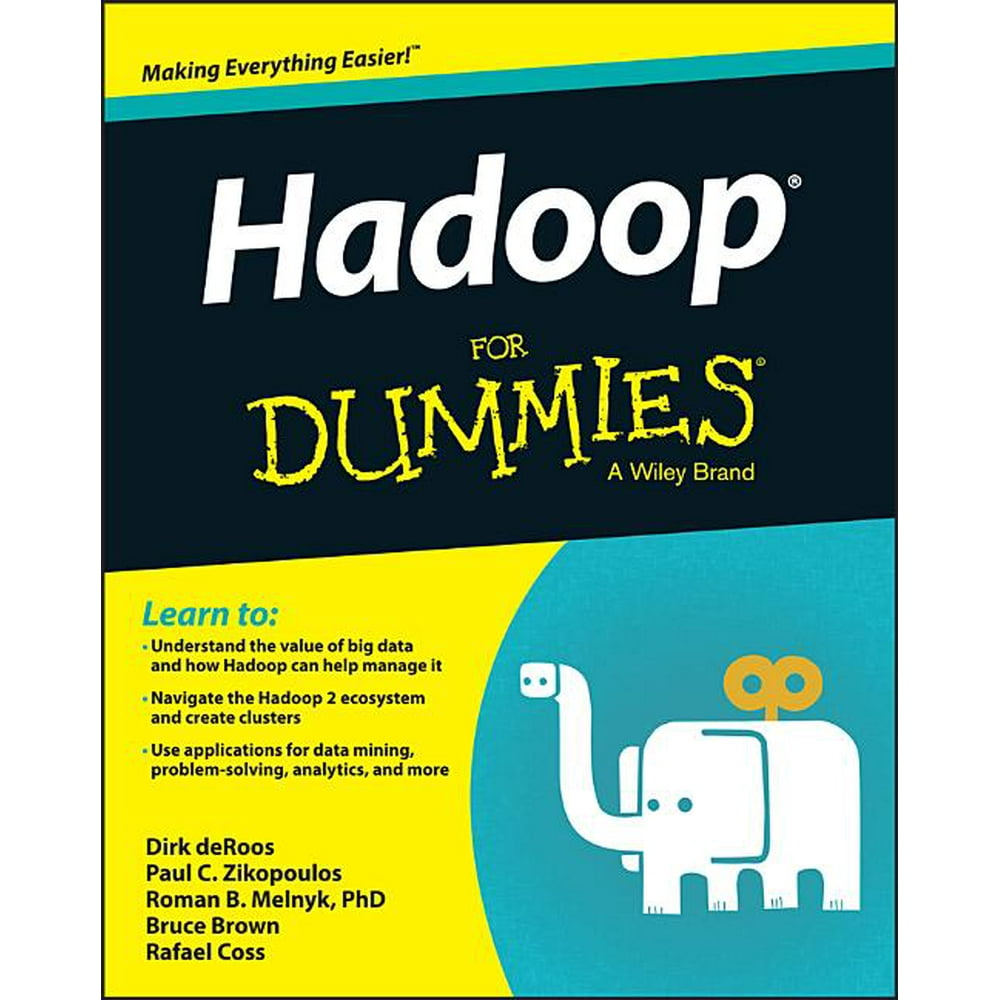Title: Hadoop for Dummies: Making Big Data Simple
Introduction:
Hadoop is a powerful open-source framework that allows organizations to efficiently process and analyze vast amounts of data. In this article, we will delve into the world of Hadoop and explore its functionalities and benefits for both beginners and seasoned professionals. Whether you’re new to the concept of big data or want to enhance your understanding of Hadoop, this article will guide you through the basics and help you leverage its capabilities effectively.
Table of Contents:
1. Understanding Big Data
2. Introduction to Hadoop
3. The Components of Hadoop
4. Hadoop Distributed File System (HDFS)
5. MapReduce: The Heart of Hadoop
6. Hadoop Ecosystem: Expanding Capabilities
7. Setting Up a Hadoop Cluster
8. Managing and Analyzing Big Data with Hadoop
9. Hadoop for Data Processing and Transformation
10. Data Warehousing with Hadoop
11. Hadoop Security: Protecting Your Data
12. Hadoop in the Cloud: Leveraging Cloud Computing
13. Real-World Applications of Hadoop
14. Challenges and Limitations of Hadoop
15. Conclusion
1. Understanding Big Data:
In today’s digital landscape, the amount of data generated is staggering. Big Data refers to extremely large and complex datasets that traditional data processing techniques cannot handle. Businesses and organizations need tools like Hadoop to effectively process, analyze, and make meaningful insights from this vast amount of information.
2. Introduction to Hadoop:
Hadoop, developed by the Apache Software Foundation, is a distributed computing framework that enables users to store and process large datasets across multiple computers using simple programming models. It addresses the challenges of distributed data processing by providing fault tolerance and scalability.
3. The Components of Hadoop:
Hadoop consists of two main components: Hadoop Distributed File System (HDFS) and MapReduce. HDFS is a distributed file system that allows data to be stored and retrieved across multiple machines, providing high availability and reliability. MapReduce is a programming model that allows for parallel processing of data across a distributed Hadoop cluster.
4. Hadoop Distributed File System (HDFS):
HDFS is the storage layer of Hadoop, designed to handle large datasets by distributing them across multiple machines. It ensures data reliability and fault tolerance by creating multiple copies of data blocks and distributing them across the cluster. This allows for efficient data processing and high availability.
5. MapReduce: The Heart of Hadoop:
MapReduce is a programming model used to process and analyze large datasets in parallel across a distributed Hadoop cluster. It breaks down data processing tasks into smaller, manageable chunks, which are executed in parallel across the cluster. The output of each task is then combined to produce the final result.
6. Hadoop Ecosystem: Expanding Capabilities:
The Hadoop ecosystem consists of various additional tools and frameworks that enhance the capabilities of Hadoop. These include tools for data ingestion, real-time data processing, graph processing, machine learning, and more. Some popular ecosystem components include Apache Hive, Apache Spark, and Apache HBase.
7. Setting Up a Hadoop Cluster:
Setting up a Hadoop cluster requires careful planning and configuration. It involves installing and configuring the necessary software, establishing a distributed file system, and optimizing the cluster for performance. Various distributions provide user-friendly interfaces to simplify the process, such as Cloudera, Hortonworks, and MapR.
8. Managing and Analyzing Big Data with Hadoop:
Hadoop offers a range of tools and solutions for managing and analyzing big data. These include data integration, data quality, data governance, and data visualization. With the right combination of tools, organizations can gain valuable insights and make data-driven decisions.
9. Hadoop for Data Processing and Transformation:
Hadoop’s ability to process and transform large volumes of data efficiently makes it ideal for various data-intensive tasks. It excels in scenarios such as log processing, web analytics, sentiment analysis, and recommendation engines. Its scalability and parallel processing capabilities enable businesses to process data in real-time or batch mode, depending on their needs.
10. Data Warehousing with Hadoop:
Hadoop can also serve as a powerful data warehousing solution, allowing organizations to store and analyze structured and unstructured data in a cost-effective and scalable manner. By leveraging distributed computing power, businesses can perform complex queries and generate valuable insights from their data.
11. Hadoop Security: Protecting Your Data:
As big data contains sensitive information, ensuring the security of data stored and processed in Hadoop is crucial. Hadoop provides various security features, such as authentication, authorization, encryption, and auditing, to protect data from unauthorized access and ensure compliance with privacy regulations.
12. Hadoop in the Cloud: Leveraging Cloud Computing:
Cloud computing has revolutionized the way businesses store and process data. Hadoop can be seamlessly integrated with cloud platforms like Amazon Web Services (AWS) and Google Cloud Platform (GCP), enabling organizations to leverage the scalability and cost-effectiveness of the cloud while benefiting from Hadoop’s analytical capabilities.
13. Real-World Applications of Hadoop:
Hadoop has found applications in various industries, including finance, healthcare, retail, and telecommunications. Some common use cases include fraud detection, customer analytics, recommendation systems, predictive maintenance, and log analysis. The flexibility and scalability of Hadoop make it a powerful tool for solving complex business challenges.
14. Challenges and Limitations of Hadoop:
While Hadoop offers numerous advantages, it is important to consider its challenges and limitations. These include the complexity of setting up and managing a Hadoop cluster, the need for skilled professionals, and the potential for data loss if proper backup and recovery strategies are not in place. Additionally, the evolving nature of big data technologies may require organizations to adapt and stay updated to stay ahead.
Conclusion:
Hadoop has revolutionized the field of big data by enabling organizations to process and analyze vast amounts of data efficiently. With its distributed computing model and rich ecosystem, Hadoop offers scalable, cost-effective solutions for managing and deriving insights from big data. By harnessing the power of Hadoop, businesses can stay competitive and make data-driven decisions with confidence.
FAQs:
Q1: Is Hadoop suitable for small businesses?
A1: Hadoop’s scalability makes it suitable for businesses of all sizes. Small businesses can benefit from Hadoop by starting with a smaller cluster and gradually expanding as their data requirements grow.
Q2: Can Hadoop process real-time data?
A2: Yes, Hadoop can process real-time data using frameworks like Apache Storm and Apache Flink. These frameworks provide real-time stream processing capabilities, allowing organizations to analyze data as it arrives.
Q3: What programming languages are commonly used with Hadoop?
A3: Hadoop supports multiple programming languages, with Java being the most commonly used. Other languages include Python, Scala, and R.
Q4: Is Hadoop a replacement for traditional relational databases?
A4: Hadoop complements traditional relational databases by handling large-scale data processing and analysis tasks that traditional databases may struggle with. It is often used in conjunction with databases like MySQL, Oracle, and PostgreSQL.
Q5: How can I get started with Hadoop?
A5: To get started with Hadoop, you can explore online tutorials, enroll in Hadoop training programs, or consider seeking professional guidance from experienced Hadoop consultants.
Remember, always validate the information mentioned in this article with trusted sources as technologies and tools evolve over time.
Gallery
For Dummies (Computers): C++ For Dummies, 7th Edition (Edition 7

Photo Credit by: bing.com / dummies edition books book pdf 7th 3rd ebook paperback cover davis stephen read library overstock programming reference eng beginners wiley
For Dummies (Computers): Coding For Dummies (Paperback) – Walmart.com

Photo Credit by: bing.com / coding dummies book nikhil abraham amazon paperback kids computers ages started getting zoom flip reading actions waterstones authors walmart
Introduction To Hadoop For Dummies [Module1.2] – DEV Community
![Introduction to Hadoop for dummies [Module1.2] - DEV Community](https://res.cloudinary.com/practicaldev/image/fetch/s--1WVy79Rq--/c_imagga_scale,f_auto,fl_progressive,h_420,q_auto,w_1000/https://dev-to-uploads.s3.amazonaws.com/i/1nx89m670v9pv2vc9bh1.png)
Photo Credit by: bing.com / dummies module1 hadoop dev anand rahul
For Dummies (Computers): Hadoop For Dummies (Paperback) – Walmart.com

Photo Credit by: bing.com / dummies
Hadoop For Dummies On Apple Books

Photo Credit by: bing.com /






